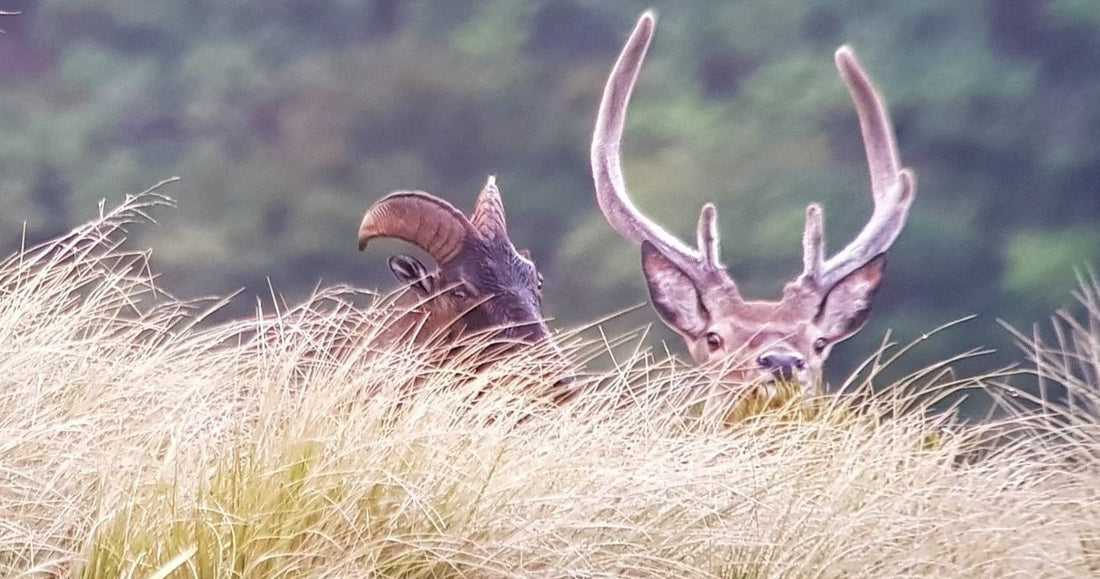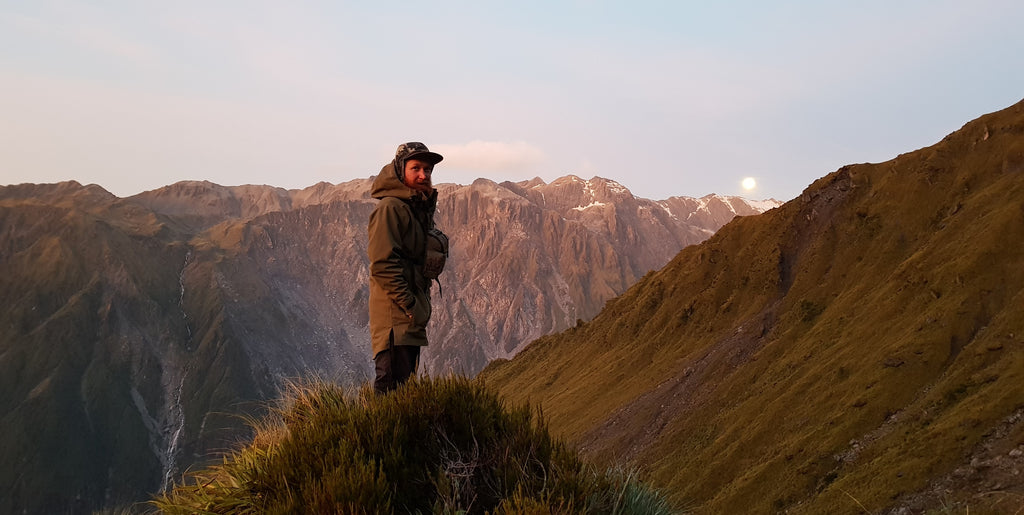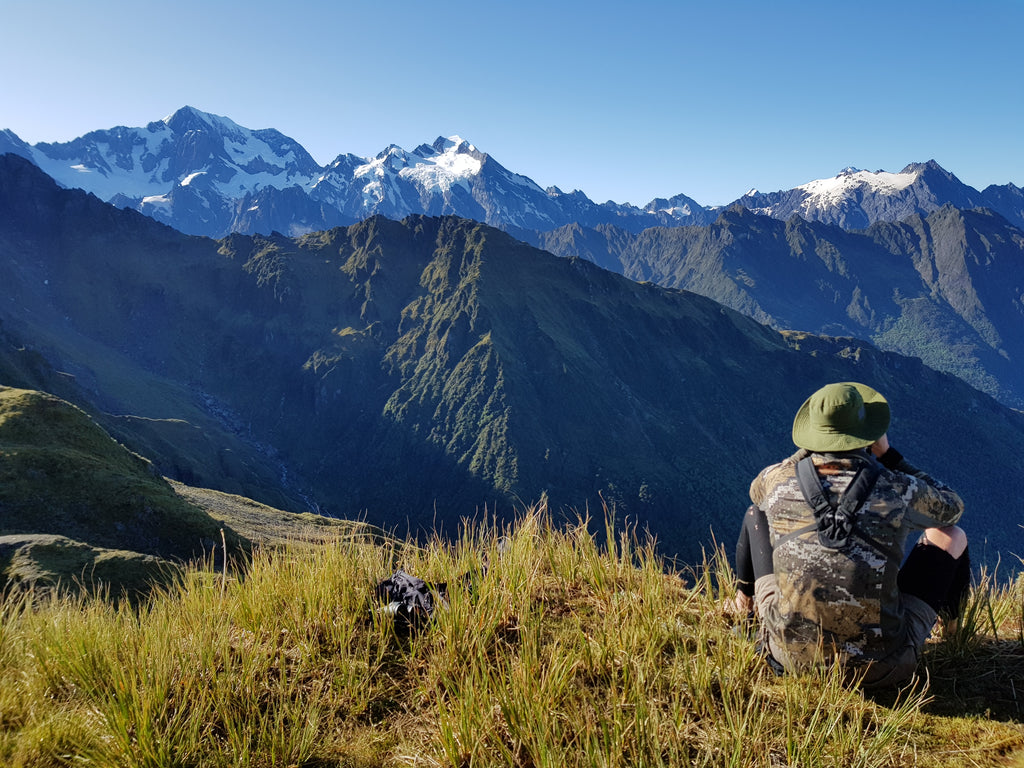
Waitangi Stag
Every now and then you get lucky with the weather. Coming up to Waitangi weekend 2020, almost unbelievably, the forecast for the coast looked ok! This hunt is almost a tradition for me now and over the years I have been reasonably successful. Even when the hunting doesn’t quite go as planned, being up high in the Alps is reward enough.
Those of you who hunt the coast will know all about the usual daytime convection cloud that plagues the hills during summertime. It forms because of the moisture rich environment, the heat of the sun and the anabatic wind. It often comes in mid to late morning and dissipates during the late afternoon, getting sucked out of the valleys by the katabatic wind. This gives you good windows to hunt in and actually makes travel during the daytime ok as long as you know where you are going! As it eventuated, this cloud was more pesky than usual!

My offsider for this trip was a bloke called Theo who I have done the trip with a few times now. We know the area pretty well! We set off after lunch on Waitangi day itself. The objective was to gain altitude and get ourselves in a glassing position for the evening. It’s about a 1400m climb to our first campsite and for the most part, it was cloudy! At least it kept the heat of the day off us. Camp was set and the waiting began. A lot of waiting! The cloud finally broke up at about half past eight giving us a small window for glassing while the light was good. The site we camped in gives a great view of almost an entire catchment as well as another kind of hanging basin. We saw a reasonable number of Chamois and the odd bull Tahr, but no deer. We enjoyed a spectacular west coast sunset, got some tucker down and hit the hay.

Day two dawned clear. Breakfast was done in the dark and we waited patiently for glassing light. A nice chamois buck appeared about 150m from camp, but he was a little young to be on the menu. As we glassed we picked out more and more animals. No Tahr, but the deer had come out. A hind, spiker and fawn grazed the open tussock faces while a group of young stags chased each other round some clearings. A family group of Chamois played in the bluffs. Life was good. But where were the big stags……
Unfortunately, our glassing session was interrupted by the cloud. By 9am we were socked in. We packed up and hit the hill. You have to take care when traversing the ridgeline in the cloud. It’s really not great to get drawn down off the main ridge into side creeks and bluffs so always remain aware of where you are walking and check you maps.

Up and over the high point of the trip we climbed. It’s about an 1800m vertical difference from where the truck is parked to this point. For a few more hours we plugged away through the cloud and set up our next camp. I’d like to be able to tell you a bit more about this day except that nothing really happened! The cloud cleared late in the afternoon for about 10 minutes, in which time we saw another family of Chamois and some young bulls, but then it came straight back in and never cleared. We sat there patiently waiting until it was dark. Nothing happened.
I woke at 6am to more cloud. Now that was a bit disheartening. We were in prime country and could not see a thing! We got up and fed and watered ourselves anyway. Fortunately, it cleared an hour or so later. Glassing commenced. Deer, Chamois and Tahr! They were all here! We glassed a mob of stags we have seen in previous years. They are all around the three to four year old mark now and some are showing great potential, already growing out all their lower tines with good length and spread to boot. Still no big stags though. We knew they were here somewhere but couldn’t help but think the full moon was making them feed at night.
There was a front supposed to pass through that morning and it did at about 9am. First with light drizzle which turned to rain and then snow. We retreated to a rock bivvy and set about making improvements to the sleeping quarters while one of the local Kea gang supervised. It was a slow old day really given that we had nowhere to travel too. Eating and snoozing kept us “busy”. As the front passed, we were given the best glassing evening so far. It was perfect. As soon as it cleared, we started picking up animals. After an hour or so Theo said “there’s a better one!”

I swung the spotter round and confirmed that yes indeed it was a better one! A mature 10 pointer. Big neck, big guts, low coronets and decent mass. I thought we should go have a closer look. My call was that he was a possible shooter and it was Theo’s shot. We had a reasonable amount of shooting light left and the stag was quite settled eating his evening meal of Carmichaelia.

We made our way closer and managed to get setup around 200m away from the stag. All we could see was antlers in the brush. About 100m away to our left there was an 8 year old bull watching us, seemingly unperturbed by our presence. Amazingly, he was soon joined by a young stag, The stag wasn’t quite so calm and the bull got a little jittery. I told the Bull several times how lucky he was that we were looking for stags!

We waited and waited. Light was surely fading. We had planned our stalk to be above the stag, but not directly above. As the air cools, the air begins to drop down the hillside, carrying your sent with it. Despite our prior planning, the stag got our sent. We both felt the change in airflow as it started descending and wondered how it would pan out. As it happened, it worked out ok. The stag stopped feeding and became nervous. He walked up the face and stood broadside in an opening. It was all on Theo from here. I had the spotter on him and the camera rolling. He had obviously made his call on the Stag and the report from the .243 rolled through the valley. I quickly looked for the Bull, but he was gone.
By this time it was nearly dark, but with the supermoon rising, we were happy to go and retrieve him. I also didn’t want to have to come all the way back down the hill to pick him up in the morning! Using an obvious stick as a marker we set off. It was properly dark when we got down there. We found the stick and lined it up from where the shot was taken. I flicked the light on and started looking. I found a horrid little scrub filled gut and thought “I hope he’s not in here”. Of course then I saw a hoof under the bushes.
With considerable effort, we dragged him out to a more open area. We sat and admired the animal and his antlers. Our assessment was correct. A mature stag with decent length, mass and lower tines. He lacked his inner royals but I doubt if he would ever have grown them. If he was ever going to, he would have done so by now. We took what we could carry and set off up the hill, the moon lighting the way. It was 11pm when we got back to camp. Dinner tasted extra good that night and sleep sure came easily!

The next day dawned clear as a bell. Once again we were on the glass as soon as the light was good. Again the animals were out, but again, not the ones we wanted. After the morning session we packed up our camp, cleaned up the head and set off down the hill. We glassed along the way seeing a few more animals. We moved from the open high ridges into the scrub band, battled away for a while, then popped out onto an open slip. From there we got into a small boulder filled creek that took us to the valley floor.

The dull march down the valley was broken up by the need to clamber up and around a sheer bluff. Luckily there were a few Rata trees to hang on to! It was a somewhat awkward affair with heavy packs, rifles and passing a set of antlers to one another but it took surprisingly little time. A few more kms and we were back where we started, looking back up at the range once again cloaked in cloud.
All we had needed was a few hours to get the job done on the hill. Luckily for us we had been in the right place at the right time when that cloud lifted. It wasn’t so lucky for the stag. I guess the point of the story is, do a bit of research and scouting and if you see the weather window you need, make it happen!
Apart from the above heart warming story, here are a few tips on increasing success in such a hunt.
Research the area
Don’t just head on in somewhere and expect to find what you are looking for (to be fair the old random lets go check it out tactic does pay off sometimes). Check the access, check the terrain, be familiar with the maps of the area, use aerial photographs (e-scouting), do a few trips at different times of the year, find where the animals live, what is the waro activity like, has there been any poison (this can be a positive in some areas as it means no waro for 4 months), what is hunter pressure like, what are the weather patterns at different times of the year?
Select your target animal
While it’s hard to pass on another species sometimes, if you are sure what you want is hiding away somewhere, just stick to it. You’ll be disappointed if you let off a shot and see what you really wanted legging it over the horizon.
Select your campsite well
The weather plays a big part in where you will set up. But you really want to wake up in a spot where you don’t have to go far to be in your intended glassing spot. You’ll know where you want to glass from all that research you did! Ideally your camp wont be somewhere the animals you want to hunt can see or will have the chance to smell or walk past. Often the other side of the ridge from the catchment you want to hunt is a good option, again weather dependent. You’ll also know where the water is from your research! It sucks when you run out of water!
Remember the airflow
The usual flow of air during the day will push up the faces. This of course can be affected by any prevailing wind or weather system. This makes being up high great for glassing in the morning and early evening. But remember that later in the evening the air will cool and drop down the face carrying your scent with it.
Do lots of glassing
Sit on your bum and glass for a long time, then do some more and some more again. Because you have picked out your glassing spot so well, you can let your optics do the walking. Take your time and go over likely looking area again and again. If you don’t see anything but you are sure what you are after is there, just keep looking. Give it at least one morning or evening of glassing before moving on. It is very beneficial to have a spotting scope. I know lots of people are now using high zoom cameras, which also works quite well. I like my spotter though (they work better in low light) and have a “phoneskope” to take photos and videos with. The bonus of having a screen (goes for cameras too) is that your mates can have a look at the same time. Check out Phoneskope products here.
Know the limits of you and your rifle/bow
Practice your shooting when you can and work out what your capabilities are in terms of taking a shot you know will provide a clean and ethical kill. I’ve buggered this up before and it feels terrible. Just don’t take a shot unless you are sure you will kill what you are aiming at. Practice at different ranges and angles if you can. Shoot off different rests, vary it as much as you are able. Know your ranges and drops. My preference on the hill is to use a rangefinder with a TBR function and a dial up scope for the longer shots. Some don’t like or want to do this and that’s all good, but I’m not a master marksman nor do I have an accurate rangefinder in my eyes. Distances over some terrain are very deceiving! Always try to close the gap as much as you can. If you get it you have to go over there anyways!
Descending from the hill
Don’t go down a creek unless you are sure there is a way out. Many of the creeks in our hills start out nice at the top. They continue to be nice and then you are in a gorge with a waterfall and you cant climb out or down. You have to go all the way back up. It’s a dangerous situation where people often make a bad call due to “get home itis”, ie making bad calls to get off the hill quicker. The general rule is that creeks are for going up, not down. From your map and aerial photo research you will probably have a good idea of the terrain anyway and know what the likely good routes down are. Obviously maps don’t show you what is actually there, but they usually point you in the right direction for a start.
Know your physical/mental capabilities
These hunts can be hard. You need to be confident your body can handle it. The hills are big, and the terrain is steep. You need to consider what sort of terrain you are comfortable operating in. Sure, there are times when you may think it’s a bit sketchy, but overall, you should only ever go through terrain you know you will come out the other side of. If its really bad, find another way. If you get to a point where you are a bit fried (mentally or physically), it’s time to sit down, have a drink, have a feed and do a bit of thinking. Its not helpful to be feeling stressed out or a bit fuzzy in the hills, that’s when you will make poor decisions. Refuel yourself! You’ll be amazed at the difference if you eat and drink well throughout the day. You should also consider whether you need to bump up the fitness level before embarking on a hunt like this. Joseph Peter wrote a good yarn about training for mountain hunts which can be found on his website hardyardshunting.co.nz.



